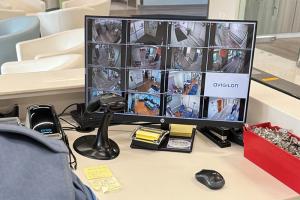Words can lie; body language cannot

Effective communication with colleagues goes beyond words.
Image from Getty Images
We all come into this world experts at one thing, and it doesn’t include knowing how to keep our parents awake through the night. Actually, scratch that. We all come into this world experts at two things.
Besides possessing the innate skill to induce sleep deprivation, we are born experts at using nonverbal communication. When a baby is happy, their face beams with joy and their body relaxes. Everyone in the room is absolutely sure they are in a good mood. When said baby is unhappy, however, their face scrunches up in abject discomfort and their body grows rigid. Everyone within earshot is absolutely sure baby is defiantly not in a good mood despite the fact that they have yet to grow the synapses, train the muscles and observe the patterns to form words. Nonverbal communication is the only way infants can express their desires to those poor, poor exhausted people they eventually learn the word for: parents.
Growing up, we eventually learn to will our brain, lips, tongue, mouth, throat and lungs into forming words and our ears into understanding them. Yet throughout those early years, we continue to paint our nonverbal communication in big, broad brushstrokes, Vincent van Gogh’s of voluminous messages communicating emotions through our body. Anyone who has witnessed or had to respond to a toddler who has grown limp and dropped to the floor, wailing because someone had the audacity to stop them from doing something they were interested in immediately gets the message that little body is sending: “You’ve gravely besmirched my honor, adult, and you will pay for it by having to respond to this temper tantrum.”
As we mature into adulthood, our nonverbal communication becomes more like a Seurat, “A Sunday on La Grande Jatte” emoting subtle cues that up close quietly convey miniature messages and from far away amount to a masterpiece of meaning. Unlike learning to speak or read words, we receive no formal training in learning how to read nonverbal communication. All the training for that occurs on the job of life, and some of us may have had an unexcused absence on those particular days. To be a truly impactful team member, colleague, leader, adult in the world, gaining skills in reading nonverbal communication is a power skill we must work to strengthen.
Personalities and nonverbal misunderstanding
How do you know if someone is sad if they smile all the time? How do you know someone is happy if they frown all the time? Communication is a team sport. Anything one communicates doesn’t have an impact until it has been received and processed by the person they are communicating with. Processing communication requires one to assess the body language, tone of voice, vocal inflection and other subtle nonverbal cues of a person. To effectively gauge those cues, it is important to understand the personality of the person one is communicating with.
Shelbie Watts, content marketing manager at Homebase, a provider of staff management technology, provides a thorough overview on the different personality types one might encounter in a workplace setting. She highlights several personality types observed within the Myers-Briggs Type Indicator assessment. This assessment offers lots of different rabbit holes to travel down if you are interested, but for our purposes let’s focus on the personality types the assessment lays out.
- The adventurer. Open-minded, flexible, artistic, open to experimentation, driven by curiosity.
- The advocate. Introverted, imaginative, idealistic, principled, approaches life with deep thoughtfulness.
- The architect. Rational, quick-witted, introverted, independent, thoughtful, tactical.
- The campaigner. Free-spirited, outgoing, open-hearted, adventurous, craves emotional connections with others.
- The commander. Extroverted, charismatic, confident, rational, determined, high-achieving.
- The consul. Caring, social, eager to help, supportive, generous, reliable, places a high value on community.
- The debater. Extroverted, quick-witted, curious, not afraid of disagreements, a rule-breaker.
- The defender. Introverted, unassuming, warm, efficient, responsible, detail-oriented, protective.
- The entrepreneur. Extroverted, energetic, perceptive, has a tendency to “leap before they look.”
- The executive. Excellent administrator, lover of tradition and order, honest, dedicated, pragmatic decision-maker.
- The logician. Creative, willing to experiment, curious, dreamy, introverted.
- The logistician. Practical, factual, reliable, willful, observant.
- The mediator. Creative, imaginative, dreamy, empathetic, introverted.
- The protagonist. Warm, values helping others, extroverted, idealistic, charismatic.
- The virtuoso. Bold, practical, experimental, curious, values first-hand experiences, fair.
It is difficult not to build our assumptions about how others communicate based on our own preferred communication approach. As a middle-aged member of Generation X, I assume that everyone else is jaded and sarcastic. As a man, I assume that everyone else is seeking my perspective and explanation about everything. As a Chicagoan, I assume that everyone else thinks Packers fans are weirdos. Thankfully, the world is filled with earnest, optimistic people from other generations who possibly find value in wearing a foam cheese hat out in public.
Do a mental exercise and think about the personalities of the people that you work with through the rubric of the Myers-Briggs personality types. Think about the consul who always listens with their head slightly tilted and eyes that communicate empathy. Think about the debater whose body seems to radiate joy as they meticulously point out what is wrong with the approach you just proposed. Think about the architect quietly scanning the room while sitting in a group discussion, walking away and delivering impactful results from synthesizing everyone’s various perspectives.
Now think about when you see two colleagues that just can’t seem to make sense of what the other is trying to communicate through their body language. Does the entrepreneur in the group tend to misread the logistician’s nonverbal cues? Is the executive not getting what the virtuoso is expressing by their stance and facial expressions? Observing the personality type of the person you are interacting with will provide you with a basis to help understand what signals their body is trying to communicate to you.
How to improve reading nonverbal cues
The mission to optimize the health care physical environment is achieved through groups of people across multiple types of organizations coming together around a shared goal to improve the way patients, families and staff experience the consumption of health care. Within and across those organizations, people from a diverse set of lived experiences need to interact with and understand one another. For that shared mission to become a shared reality, your ability to read the nonverbal cues of people different from yourself in personality and profession is an absolute necessity. Karla Driskill, president of cultures at staffing firm the Hollister Group, provides five tips to improve nonverbal communication skills. Karla’s guidance includes:
- Look people in the eye to express your interest and attention.
- Monitor your facial expressions to ensure they match the message you are trying to send.
- Pay attention to bodily proximity and the role that culture and acculturation play in how people interpret that proximity.
- Observe your posture, the message it is sending while verbally communicating and whether your posture is emphasizing or undercutting the message you want to convey.
- Listen to your tone of voice and, much like your posture, whether it aligns with your communication goals.
While these tips are framed as actions you can take to improve your own nonverbal communication, they also provide a road map for reading the cues of the person with who you are communicating.
Are their words saying “I’m so excited for this new opportunity?” while frowning, slouching and doing their best imitation of a robot like Terry Crews on the “Tonight Show Starring Jimmy Fallon.” Or are they saying “I’m so excited for this opportunity!” with a smile on their face, their chest out and shoulders low, positively radiating joy like Terry Crews on TikTok.
When you notice disconnection between the verbal and nonverbal messages someone on your team is sending, and taking into account that person’s personality type, consider digging deeper with that person in a safe setting, working to gain a better understanding of that disconnect. Maybe that person is genuinely excited about the opportunity but just found out painful news about an aging loved one. Or maybe they are not excited about the opportunity but need to pretend they are because of some friction between them and another team member. Extend empathy; seek to support.
As with practicing all the power skills we explore in this column, trying these actions to improve your nonverbal communication might be uncomfortable at first. They could make you itchy, or sweaty or quite possibly gassy. The human body can be a mystery. But mysteries are entertaining to solve. Just ask Hercule Poirot or Jessica Fletcher.
Be interested in the mystery of how the words we say and the actions we take while saying them can work in conflict or cooperation. Be interested in making sure you fully understand those with who you share a mission and meal in the breakroom. Embody yourself with the spirit of sincerity when it comes to listening to nonverbal communication. And if you’ve read this far but still choose not to work on improving your nonverbal communication power skill, I will have no choice but to act like this.





